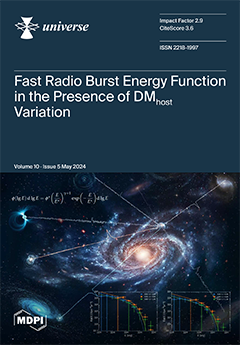To the first post-Newtonian order, the orbital angular momentum of the fast-revolving inner binary of the triple system PSR J0337+1715, made of a millisecond pulsar and a white dwarf, induces an annular gravitomagnetic field which displaces the line of apsides of the slower
[...] Read more.
To the first post-Newtonian order, the orbital angular momentum of the fast-revolving inner binary of the triple system PSR J0337+1715, made of a millisecond pulsar and a white dwarf, induces an annular gravitomagnetic field which displaces the line of apsides of the slower orbit of the other, distant white dwarf by
milliarcseconds per year. The current accuracy in determining the periastron of the outer orbit is
milliarcseconds after 1.38 years of data collection. By hypothesizing a constant rate of measurement of the pulsar’s times of arrivals over the next 10 years, assumed equal to the present one, it can be argued that the periastron will be finally known to a ≃
milliarcseconds level, while its cumulative gravitomagnetic retrograde shift will be as large as
milliarcseconds. The competing post-Newtonian gravitolectric periastron advance due to the inner binary’s masses, nominally amounting to
milliarcseconds per year, can be presently modelled to an accuracy level as good as ≃
milliarcseconds per year. The mismodeling in the much larger Newtonian periastron rate due to the quadrupolar term of the multipolar expansion of the gravitational potential of a massive ring representing the inner binary, whose nominal size for PSR J0337+1715 is
degrees per year, might be reduced down to the ≃
milliarcseconds per year level over the next 10 years. Thus, a first measurement of such a novel form of gravitomagnetism, although undoubtedly challenging, might be, perhaps, feasible in a not too distant future.
Full article





